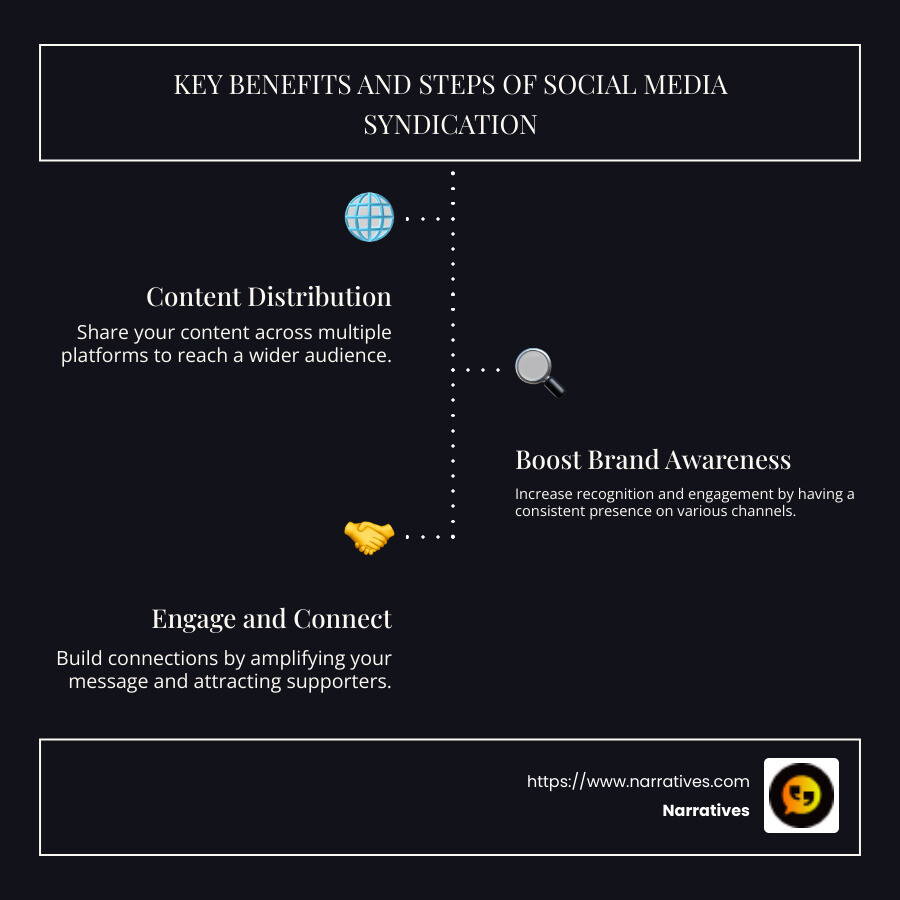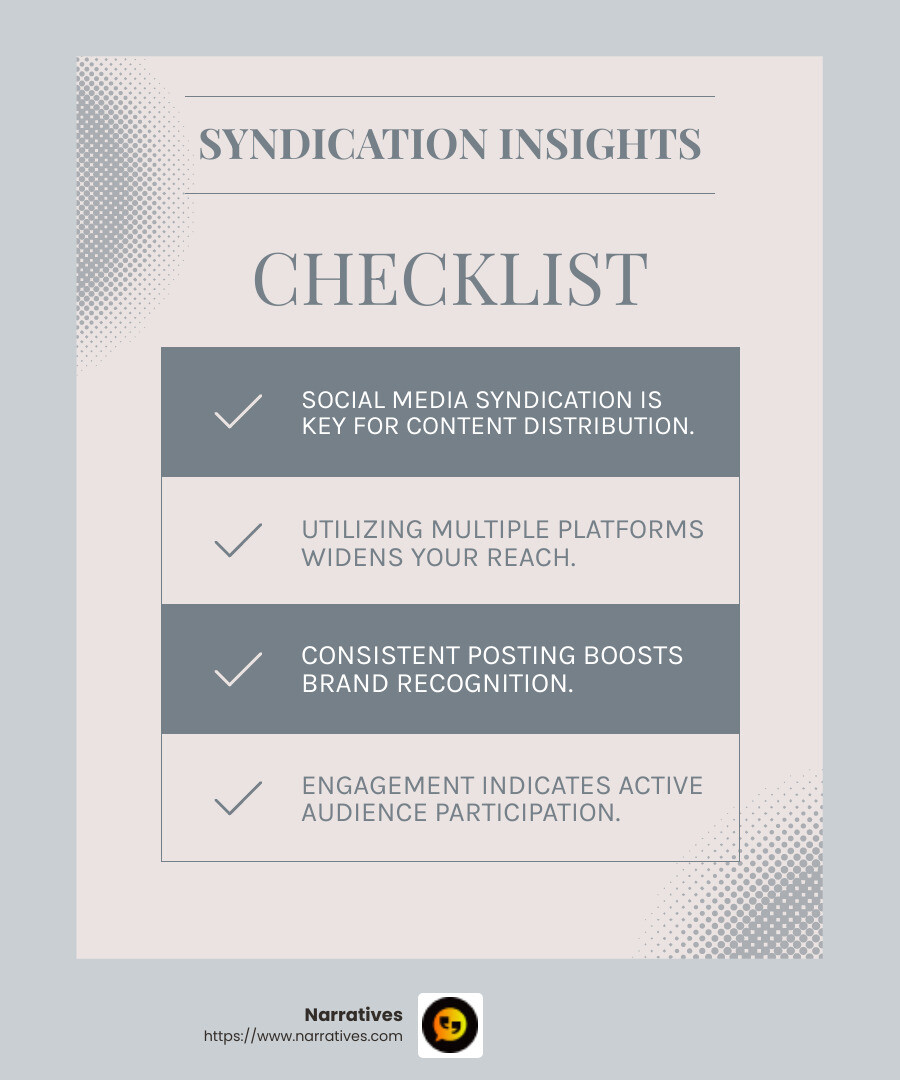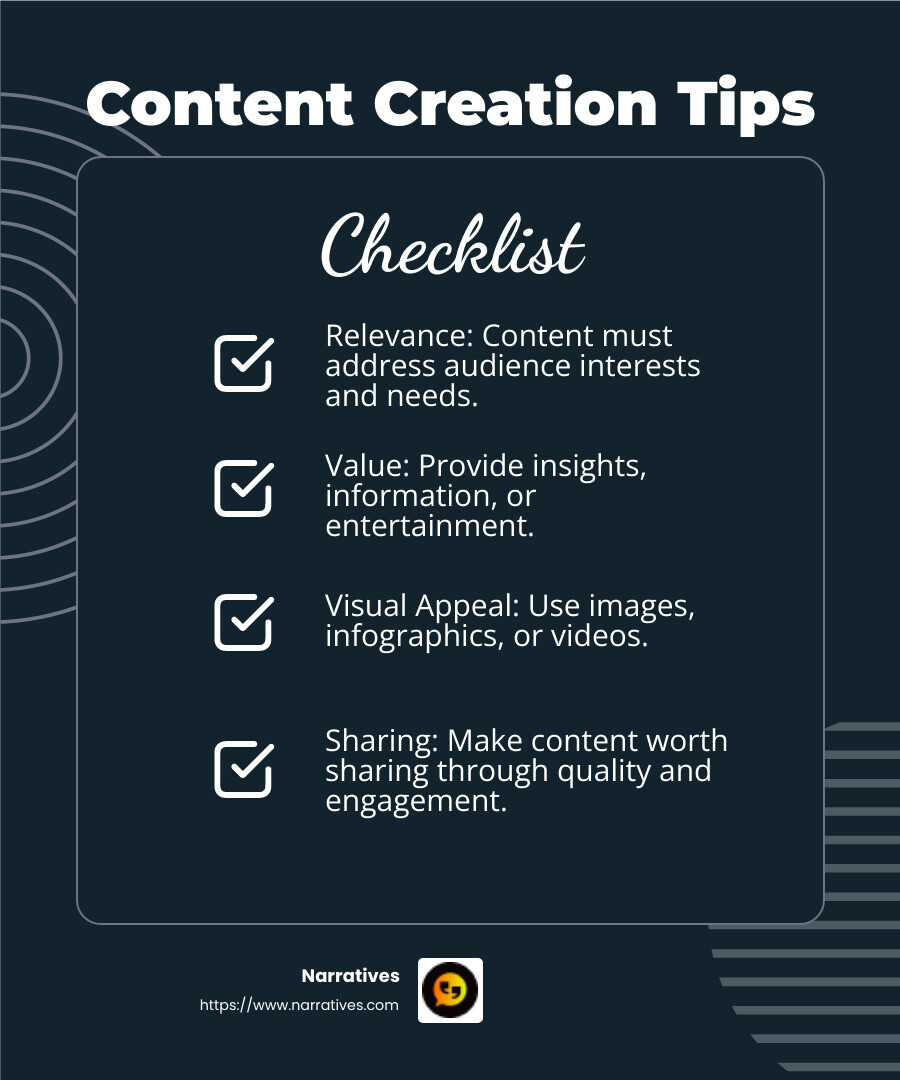Social Media Syndication: How to Expand Your Reach

Social media syndication is a vital strategy for expanding your digital reach and enhancing brand awareness. If you’ve been wondering how to share your stories across multiple platforms effectively, here's what you need to know:
- Content Syndication: It's about distributing your content to reach a wider audience.
- Digital Marketing Strategy: Works in tandem with content syndication to boost online presence.
- Increased Brand Awareness: Syndication helps more people recognize and engage with your brand.
For non-profits and socially-driven organizations, sharing your mission effectively is crucial. Social media syndication helps you build connections, amplify your message, and attract the supporters you need.
A well-executed strategy can lead to greater visibility in a crowded digital landscape, ensuring your messages resonate with the right audiences. Are you ready to lift your brand's story and connect with like-minded individuals?

Social media syndication definitions:
Understanding Social Media Syndication
Social media syndication is a powerful tool in today's digital landscape. It involves distributing your content across various social platforms to increase visibility and engagement. Let's break down how it works and why it's essential for your brand.
Content Distribution
At its core, social media syndication is about content distribution. This means taking your original content and sharing it on multiple social media channels. By doing this, you tap into different user bases, allowing your message to reach more people. Imagine your content as a ripple in a pond. The more platforms you use, the wider the ripple spreads.
Visibility
Increasing your brand's visibility is one of the main goals of syndication. When your content appears on various platforms, more people can see it. This helps your brand become more recognizable. A study found that consistent posting on social media can boost brand recognition significantly. The more familiar people are with your brand, the more likely they are to engage with it.
Engagement
Engagement is where the magic happens. Once your content is out there, the next step is getting users to interact with it. This could be through likes, comments, shares, or clicks. Engagement is crucial because it shows that your audience is not just passively consuming content; they are actively participating. For instance, including a link in your LinkedIn posts can drive 200% more engagement. This is a clear example of how syndication can lead to meaningful interactions.
Why It Matters
For non-profits and socially-driven organizations, social media syndication is not just about marketing. It's about building communities and fostering connections. By sharing content that resonates with your audience, you can attract supporters who are passionate about your cause.

In summary, social media syndication is about making your content go further. It's about reaching new audiences, increasing visibility, and driving engagement. By understanding and implementing it effectively, you can ensure your message is heard loud and clear across the digital landscape.
Benefits of Social Media Syndication
Social media syndication offers several compelling benefits for brands looking to expand their reach and impact. Let's explore how this approach can improve brand exposure, boost engagement, and drive lead generation.
Brand Exposure
By distributing your content across multiple social media platforms, you significantly increase your brand's exposure. When your content is seen by diverse audiences on various platforms, it helps build brand recognition and credibility. Think of it as planting seeds in different gardens; the more seeds you plant, the greater your chances of growth. Studies have shown that consistent social media presence makes your brand more recognizable, which is vital for establishing a lasting impression.
Engagement
Engagement is the lifeblood of successful social media syndication. When users interact with your content through likes, shares, comments, or clicks, it indicates that your message resonates with them. High engagement not only boosts your content's visibility but also fosters a sense of community around your brand. For example, a study highlighted that including links in LinkedIn posts can increase engagement by 200%. This illustrates how strategic syndication can lead to meaningful interactions and conversations with your audience.
Lead Generation
One of the most significant advantages of social media syndication is its potential for lead generation. By sharing valuable and relevant content, you can attract potential customers to your website or landing pages. This process is akin to casting a wide net to capture interested prospects. As your content circulates through social media channels, it creates opportunities for users to click on your "Call to Action" buttons, leading them down the sales funnel. Moreover, syndicating your content on reputable sites can improve your SEO, making it easier for potential customers to find your brand through search engines.
Social media syndication is a powerful strategy that improves brand exposure, boosts engagement, and drives lead generation. By leveraging this approach, you can ensure your brand message reaches the right audience, fostering growth and success in the digital landscape.
How to Implement Social Media Syndication
Implementing social media syndication effectively involves three key steps: content creation, platform selection, and audience targeting. Let's explore each of these to understand how you can maximize your reach and engagement.
Content Creation
Creating content that resonates with your audience is the first step in any successful syndication strategy. Your content should be valuable, relevant, and engaging. Whether it's an insightful article, a compelling video, or an eye-catching infographic, the goal is to produce content that your audience finds worth sharing.
- Relevance: Ensure your content addresses the interests and needs of your audience. This increases the likelihood of engagement and sharing.
- Value: Provide insights, information, or entertainment that encourages your audience to share your content.
- Visual Appeal: Use images, infographics, or videos to make your content visually engaging. Visual content is more likely to be shared across platforms like Instagram and Pinterest.

Platform Selection
Choosing the right platforms for your content is crucial. Not all platforms are created equal, and each has its unique strengths.
- LinkedIn: Ideal for reaching a professional audience, especially in industries like technology, finance, and consulting. Share longer-form content like articles and whitepapers.
- Twitter: Great for real-time updates and industry news. Use short, engaging snippets and hashtags to increase visibility.
- Instagram and Pinterest: Perfect for visual content. High-quality images and infographics work best here.
- YouTube: Best for video content, tutorials, and demonstrations.
Selecting the right platform ensures your content is seen by the audience most likely to engage with it.
Audience Targeting
Understanding and targeting your audience is essential for effective syndication. Tailor your content to meet the preferences and behaviors of your target audience.
- Demographics: Know the age, gender, and interests of your audience. This helps in crafting content that appeals to them.
- Behavior: Analyze how your audience interacts with content on different platforms. Use this data to refine your strategy.
- Feedback: Pay attention to comments and interactions. They provide valuable insights into what your audience enjoys and values.
By focusing on these three elements—content creation, platform selection, and audience targeting—you can implement a social media syndication strategy that maximizes reach and engagement. This approach ensures your content connects with the right people, driving growth and success in the digital landscape.
Best Practices for Social Media Syndication
To make the most of social media syndication, you need to follow some best practices. These practices help ensure your content reaches the right audience and keeps them engaged. Let's explore three key areas: consistency, messaging, and automation.
Consistency
Consistency is crucial in building and maintaining your online presence.
- Regular Posting: Decide on a posting schedule—daily, weekly, or monthly—based on your resources and audience preferences. The key is to deliver a steady stream of content.
- Brand Elements: Use consistent branding across all platforms. This includes logos, color schemes, and tone of voice. Consistency helps reinforce your brand identity.
- Content Quality: Maintain high-quality content across all posts. Quality is more important than quantity when it comes to engaging your audience.
Messaging
Your messaging should be clear and custom to each platform.
- Platform-Specific Content: Adapt your content to fit each platform’s format. For example, use professional language for LinkedIn and concise, hashtag-driven posts for Twitter.
- Unified Message: Ensure your messaging aligns with your brand values and goals. A unified message builds trust and recognition among your audience.
- Engaging Content: Use storytelling, emotion, and value-driven content to resonate with your audience. Content that evokes emotions like laughter or empathy is more likely to be shared.
Automation
Automation can simplify your syndication efforts and improve efficiency.
- Scheduling Tools: Use tools like Buffer or Hootsuite to schedule posts in advance. This ensures your content goes live at optimal times, even outside of working hours.
- Content Management: Organize your content calendar to keep track of posts and ensure a consistent flow of content.
- Performance Tracking: Automate the tracking of your content's performance. Use analytics to measure engagement and adjust your strategy accordingly.
By following these best practices—maintaining consistency, crafting effective messaging, and leveraging automation—you can improve your social media syndication efforts. This approach ensures your content not only reaches a wider audience but also engages them effectively, driving brand growth and success.
Frequently Asked Questions about Social Media Syndication
What is social media syndication?
Social media syndication is the process of distributing your content across multiple social media platforms to improve visibility and engagement. By sharing the same content on platforms like Facebook, Twitter, LinkedIn, and Instagram, you aim to reach a broader audience. This strategy helps maintain a consistent brand message and increases the chances of interaction with diverse audiences. Automation tools can simplify this process, ensuring timely and efficient content sharing.
How does social media syndication differ from content syndication?
While both involve sharing content across different platforms, they serve slightly different purposes. Social media syndication focuses on distributing content specifically on social media platforms to boost engagement and brand visibility. In contrast, content syndication involves republishing content on various websites or platforms, often to reach new audiences and improve authority.
For instance, a blog post may be syndicated on multiple websites, which can help in gaining backlinks and improving search engine rankings. On the other hand, social media syndication would involve sharing that same blog post link on social platforms to drive traffic and interaction.
Can social media syndication improve SEO?
Yes, social media syndication can indirectly improve SEO. While social media links themselves don't directly influence search engine rankings, increased visibility and engagement can lead to more people visiting your site. This can result in more backlinks, which are crucial for SEO. Additionally, social signals—like shares and likes—can indicate content relevance and popularity, potentially influencing search engine algorithms.
To maximize these benefits, ensure that your content is shareable and includes links back to your original site. This drives traffic and improves your site's authority in the eyes of search engines.
Conclusion
At Narratives, we believe in the power of storytelling to lift underrepresented voices and drive meaningful change. Our focus on non-profit partnerships allows us to help organizations share their impact stories, inspiring action and building trust within communities. By leveraging social media syndication, we extend these stories across diverse platforms, amplifying their reach and ensuring they resonate with a wider audience.
Social media syndication is not just about spreading content; it's about crafting a narrative that connects emotionally with your audience. We work closely with non-profits to create high-quality, multimedia content that showcases their missions and achievements. This approach not only boosts visibility but also fosters genuine engagement and support.
Our strategy is simple: use multimedia storytelling to highlight the challenges and triumphs of the communities we serve. By doing so, we differentiate ourselves through a commitment to social impact and community-driven storytelling. This aligns perfectly with our goal of increasing brand exposure and generating leads for non-profits.
Ready to expand your reach and make a difference? Learn more about our services and find how Narratives can help tell your story in a way that truly matters.


